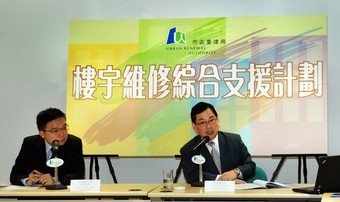
URA integrates and enhances building rehabilitation service
The Urban Renewal Authority (URA) today (Tuesday) announced that it would integrate and enhance the Integrated Building Maintenance Assistance Scheme (IBMAS) to tie in with the forthcoming extension of its service area to the whole of Hong Kong, with an aim to benefit more property owners living in unsatisfactory living condition.
The IBMAS is a one-stop building rehabilitation service jointly managed by the URA and the Hong Kong Housing Society (HKHS) since 1 April 2011, providing technical and financial assistance to eligible property owners of private residential/composite buildings. With respect to the 2011 Urban Renewal Strategy which stated that rehabilitation is one of the URA's two core businesses, the URA has taken up the role to handle all new IBMAS applications in Kowloon, Kwai Tsing and Tsuen Wan since 1 April 2013. Beginning from 1 July 2015, the URA will further expand its services by receiving and processing all new IBMAS applications in the whole territory.
The URA has so far assisted about 400 buildings to carry out
repair works in common area and provided Owners' Corporation
Formation Subsidy to about 250 buildings under IBMAS within its
service areas.
Speaking at a media briefing, Head of Building Rehabilitation
Division of the URA, Mr Lawrence Tang, said the integrated and
enhanced scheme would allow URA better allocate resources to assist
more property owners who are living in buildings which are in
relatively bad condition to improve their living environment.
Under the new arrangement, the eligibility criteria for IBMAS will change from private residential/composite buildings aged 20 years or above to 30 years or above. It is aimed to allocate resources to help those buildings built in or before mid-1980s which are comparatively not so well maintained or managed.
The URA is introducing the Green Incentive Subsidy (GIS) under the "Common Area Repair Works Subsidy" to encourage property owners to use environmentally-friendly building materials and install energy-saving facilities when carrying out building maintenance and repair works. The maximum amount of GIS is HK$600,000 per owners' corporation or HK$1,500 per property unit. The new subsidy has also consolidated two miscellaneous minor subsidies, which received little interests from owners. The IBMAS also covers Owners' Corporation Formation Subsidy and Home Renovation Interest-free Loan.
The URA will focus on the implementation of the Common Area Repair Works Subsidy which is popular among property owners, while it will cease to accept application for the Common Area Repair Works Interest-free Loan in order to utilise resources more efficiently. Property owners in financial needs for building rehabilitation can apply for the Building Safety Loan Scheme administered by the Buildings Department and the Building Maintenance Grant Scheme of Elderly Owners managed by the HKHS.
The URA will continue to provide technical support and will commission independent building surveyor consultants for building rehabilitation costs assessment and professional opinions. Furthermore, the URA will enhance the website "Building Rehab Info Net" to include more comprehensive information and case sharing so that property owners can better understand the building rehabilitation process.
"The URA plans to handle about 250 applications each year, which are more than the annual average number of buildings handled by the URA and HKHS together in the past few years. Building safety would be a primary consideration in determining the priority of the applications," Mr Tang said.
Mr Tang said that about 13,000 buildings aged 30 years or above in Hong Kong are estimated to be eligible for applying IBMAS. The URA believes proper building rehabilitation will help slow down the ageing process of buildings and extend their life span, which in turn not only slow down the pace of urban decay, it also promotes sustainable development.
Members of the public who wish to know more about the URA's rehabilitation service can visit the Building Rehab Info Net at http://www.buildingrehab.org.hk and the URA website at http://www.ura.org.hk/, or contact the Building Maintenance Assistance Scheme Hotline at 3188 1188.
(ENDS)
